« July 2006 | Main | September 2006 »
August 31, 2006
NextFest Contest to Design a Wireless Hotspot Logo
The Wired NextFest is having a contest to design a logo for hotspots. It's supposed to be the equivalent of the worldwide symbols for "no smoking" or "bathroom".I actually thought there was one of these (vague memory of cirles radiating from an antenna...) but an image search for wireless hotspot reveals that although those are indeed common themes, there doesn't appear to be any standard.
I'm always up for something like this, so here's my first cut:

A little edgy, a little out there...I think I see one geopolitical problem however: British people may object to the spelling of "iz". Hmmm, have to go back to the drawing board. The deadline is September 6th.
Posted by AdamBa at 12:34 PM | Comments (2) | TrackBack
August 30, 2006
Some Funny Things Happened on the Way to the Cellar
Something familiar,Something peculiar,
Something for everyone:
A baseball game tonight!
(There is a connection: Larry Gelbart, who wrote A Funny Thing Happened on the Way to the Forum, worked as a writer/producer on MASH with Ken Levine, who was briefly an announcer on the Mariners broadcasts.)
When someone interviews for a job in Engineering Excellence, they usually have to do a "demo teach". This is where they prepare a short instructional lesson of some sort and then teach it to a class of current EE people, who take turns listening attentively, asking dumb questions, and throwing things at each other, all in the name of judging how the interviewee would do in front of a real class of Microsoft people.
Yesterday there was a demo teach about how to keep score at a baseball game, which is evidently a popular demo teach topic (the bowline knot is the other). One of the questions someone asked was "Why in the heck would you ever keep score?" (he was faking; he admitted later that he keeps score at every game he goes to). By coincidence, yesterday evening we went to the Mariners game and I of course kept score, which allows me to relay some more detail on the many appealing and appalling things that happened there. To wit:
- The most memorable thing, unfortunately, was Rafael Soriano getting hit in the head by a line drive off the bat of Vladimir Guerrero. Soriano is one of the hardest pitchers around and Guerrero is one of the hardest hitters around. The quick summary I saw in an ESPN report ("Scary moment in the 8th, Soriano hit by a line drive from Guerrero, he was taken to the hospital for tests") doesn't begin to capture what it was like to be there: the sickening noice that the ball made when it hit, Soriano collapsing on the ground with his head in his hands, the slow gathering of the players around him, the paramedic making a closed fist gesture to the dugout (what does that mean), the stretcher arriving, Soriano being slowly driven out the outfield gate, followed quickly by an ambulance siren, the jarringly familiar sight of Sean Green warming up afterwards. Luckily it seems that Soriano is doing okay.
- During the 15-minute delay while they were working on Soriano, two kids came down and sat in the seats right behind us. This is common late in the game and normally I don't care, but they were making jokes about Soriano being hurt which I didn't care for my kids to hear. So I pointed them out to Jerry the seat attendant and he proceeded to evict them with some relish (he had evidently kicked them out earlier as well, which I was unaware of). Jerry didn't just ask them to leave but actually walked off with them, and from the length of time I was gone I assume he deposited them somewhere beyond the Pale. The look they gave when he first approached them was a classic Beavis & Butthead "Who us?" expression (they actually froze still, as if that would prevent them from being noticed).
- Since I have earlier written on the arcane skill of properly distributing balls into the crowd after the final out of an inning, I am happy to say that although Richie Sexson can barely hit his weight, he has gotten much better at souvenir allocation. No more panicky tosses from the coach's box. He does a good job of moving the ball around, and if there are too many kids crowding the bottom of the aisle, he tosses it over them.
- Related to that, we had two of our kids there and we were looking to get a ball for them, as always. The first inning ended in a strikeout, but the second inning was a groundout. We are on high alert once there are two outs ("Put the peanuts down. PUT THE PEANUTS DOWN!!") and send the kids down the instant it looks like a play will be made that results in the final putout being made by someone who enters the dugout in front of us (that list being, more-or-less, the first baseman, second baseman, shortstop, and left fielder). So we sent down both kids and there was only one other kid there. Sexson threw the ball to our 11-year-old son; it was a bit of a wild throw and bounced off his glove and landed in someone's lap, but they gave it to him since he was the intended recipient.
- Of course the precending annoyed our 7-year-old greatly, but he kept trying. And lo and behold in the 5th inning the final putout was made by Lopez at second. So we sent him down (a bit late actually) and he elbowed is way into good position while I watched from the aisle higher up. The aisle by this time was very crowded in these situations, no doubt inspired by our earlier successful ball get, so Lopez decided to flip it high and dang if it wasn't coming towards me and a bit to my right, it was an empty row and I was able to reach over and get it (a nice backhanded grab if I do say so myself). A couple of (annoying) people around were agitating that I should give it to some kid who had really been nowhere near making the catch, but luckily his mom told them to shoo and I was able to give it to my own child. So now they were both happy.
- And then between those two events they were throwing t-shirts into the crowd between innings and my wife made a nice catch on one of those.
- The Mariners led off with two home runs (Ichiro and Snelling) and then Beltre hit a shot that hit the yellow line at the top of the fence, but stayed in. I gathered from something I heard on the postgame show that 3 homers to start a game would have been an AL record. This was off of Angels rookie phenom Jered Weaver. Come to think of it, the Angels later had back-to-back home runs off of Jarrod Washburn. First time both teams have gone back-to-back off pitchers with different spellings of the same name? Must contact Elias.
- Kenji Johjima managed to reach based on an error in 3 consecutive at-bats. He also made an error in the field.
- The following play happened twice, in the 3rd and 5th innings: Broussard on third, Johjima on first, batter hits a sharp grounder, Broussard gets caught in a rundown off third, gets tagged out by the catcher, Johjima winds up on third, batter winds up on second.
- After Snelling hit 2 homers, they intentionally walked Ichiro to get to him. Bases loaded, two outs, he already has two circuit clouts (as they used to call them)...but cancel the Disney Movie of the Week because he grounded out.
After Soriano got hurt, the Mariners used Sean Green for one batter (a single), then George Sherrill for one batter (a double), before finally bringing in J.J. Putz for a strikeout and fly ball, then a perfect ninth for the 6-4 win.
Something erratic,
Something dramatic,
Something for everyone:
A baseball game tonight!
Posted by AdamBa at 03:17 PM | Comments (2) | TrackBack
August 29, 2006
Photos from the Nerdcore Show
There are some pictures of the nerdcore show at the Shark Club. These help set the mood a bit, which I neglected to do in my review. The Shark Club is a small, dingy venue which feels like it's the basement of someplace else (because it is), with interior design that channels Gene Simmons. The stage is off in one corner and there are pool tables in the back. There were several video cameras rolling and also a few laptops out on the tables. I don't think I'm in any of the pictures, but keep an eye out for a black t-shirt with the word "geek." on it (my wife thought that was appropriate attire for such an occasion).Posted by AdamBa at 11:30 AM | Comments (0) | TrackBack
August 28, 2006
Nerds Rock Kirkland
So when I heard about the All Nerdcore Hip-Hop Show at the Shark Club in Kirkland last night, of course I had to go. I enlisted my friend Matt, a fellow Microsoftie, and off we went to check out the "gig" (as someone who linked to my previous article put it, "Microsoftie discovers nerdcore, adds to the litany of bad pun-based hip hop").The first act was some dude called Monzy. Monzy is evidently locked in a nerdcore battle with MC Plus+, so he performed his latest salvo in the feud. I might have to pick Plus+ in this one just based on his name, although Monzy had a good sequence of ridiculous lines like "You're tertiary storage, I'm an L1 cache."
After Monzy came Ultraklystron, who definitely puts the funk in malfunction; his hastily burned CD kept skipping and looping, leading him to lose track of his lyrics. Despite this he gave it his best shot and whatever you may think of him talentwise, he's in showbiz and I'm not.
Following that we had Rai, a female nerdcorer. At least I think she was nerdcore; it's hard to tell because she was rapping in Japanese (or the mostly-Japanese, occasional-English-on-the-chorus that you get in J-pop songs). Rai was certainly the sartorial champ of the night, with knee-high platform boots and a kimono tied with a giant red bow (she also claimed to work at Microsoft).
After Rai we had a bit of a jump in quality to Beefy. Beefy is a largeish fellow who IMHO has some decent performing skills and music. He had a nice love song (to the Internet), and then the aptly titled "Internet Celebrity".
After that came probably the most popular act of the night, Futuristic Sex Robotz. I say "most popular" because they seemed to have the most people who actually came to see them -- about half of the crowd of 50 moved forward and thronged (well, perhaps "thronged" is too strong a word) the stage. Plus they were selling t-shirts. FSR had some microphone problems but they did a great job on the crowd-pleasing stomp "F**k the MPAA", which was the musical highlight of the evening. What are the chances that MPAA, RIAA, BSA, and DMCA would all rhyme? It sure makes writing a chorus easier.
The final act was Ytcracker, along with his Spamtec crew of phlow and eGod. The jury is still out on p and eG, but Ytc definitely has the most charisma of any of the performers, and the best chance of crossing over into non-geeky hip-hop. After one song he doffed his shirt to show off his excellent "Nerd Life" tattoo (although he kept his Power Glove on), and performed most of his songs with a progressively emptier bottle of Veuve Clicquot in his hand. He also has his own "hype guy", who was responsible for getting the crowd warmed up before the set by yelling "This is %$#@^&*ing Ytcracker with the %$#@^&&*(%$#ing Spam-*&&%%##$$-tec Crew so @##@$%^$$ your %$$#&@!@@% until it ##@$%%#^$s."
Incidentally, having now see all these people perform, I can now identify the pictures from the bottom of the show advertisment. The 3 guys who look like they're about to get arrested are the Spamtec Crew, with Ytcracker in the middle; next to them is Ultraklystron dressed as a magician. On the bottom you have a closeup of Beefy, then Futuristic Sex Robotz kicking it with the chopper (one of the Robotz is missing from the photo), and then Rai looking pensive while sitting on a rock.
So, what to make of nerdcore? It certainly was an interesting experience. A week ago I had never heard of this stuff and now I own a t-shirt (from Spamtec). And no doubt these people really are performers; the fact that FSR had their Wikipedia page yanked for lack of notability is ridiculous, as has been pointed out. I don't begrudge Ytcracker his nice page (which persists despite annual attemps to delete it) but if Monzy has a page, then FSR definitely belongs.
If you're a card-carrying propellorhead and you get a chance to check out some of these bands, go for it (and despite Matt's prediction that he would be able to count the number of women on one hand, the audience was actually something like 30% female, so he would have needed both hands and at least one foot). Matt like the Robotz the best; although I agree they had something going on, my vote goes to Ytcracker. He may have to ditch his two sidekicks, but I think he has the best chance of being the subject of an "I saw him way back when" story I tell my grandchildren. Nerd up!
Posted by AdamBa at 07:24 PM | Comments (0) | TrackBack
My Talk on Software Quality Available Online
To clarify the title, if you are on the Microsoft corporate network, then you can view the recorded version of my talk "Parallels Between Environmentalism and Software Quality". Go to the mylearning site, then search for it (the word "Parallels" will work). Then click View (from my machine I have to click several different "view" buttons) and it will bring it up. It's 42 minutes long.I forced myself to watch it to evaluate how I performed as a presenter. It went pretty well; I mumbled a few sentences and missed a few minor point I wanted to mention, but succeeded in delivering the talk I wanted. One thing I noticed is that I was using a remote clicker for the Powerpoint and without realizing it I was making an exaggerated gesture each time I clicked--as in "I will now once again perform my magic wireless clicking trick for your viewing pleasure!" I need to tone that down and make it as undetectable as possible. In fact I was having a discussion recently with a few people about making a wireless clicker that was completely hidden (in your shoe, or on your fingertips), but nobody seemed to think it was a great idea. Then again they laughed at what's-his-face when he invented that really useful thingie.
Posted by AdamBa at 04:33 PM | Comments (0) | TrackBack
August 27, 2006
Jan Chong Talks About Workspace
On Thursday I went to a talk by Jan Chong, a Computer Science Ph.D. candidate at Stanford who is studying how XP and pair programming teams work. I'm interested in this because it offers some insight into the upcoming Workplace Advantage reconfiguration that Engineering Excellence is scheduled for.This particular talk was a comparison of a team working solo in cubicles vs. a team working paired in an open workspace. This is not quite the comparison that Microsoft is interested in; we are considering swapping teams working solo in offices with teams working solo in--well, in something that MIGHT be open or it might be cubicles or it might just be smaller offices with more common space. But basically we are not specifically considering pairing, and Jan's work is focused on the effects of pairing, not the effects of open space.
Nonetheless, some of her conclusions may apply to solo workers in an open space. She has interesting data on how interruptions between team members happen. In a cubicle space they happen much like in an office space: someone gets up and walks to someone else's cubicle/office, interrupting whatever they happen to be doing then. With open space, there are some cues that the interrupter can draw about what the interruptee is doing, before they decide to interrupt. These cues are stronger in pairs environments (since it's easier to tell when people are working vs. taking a break) but still they likely exist in a solo environment. Also, in an open space the interruptee is often called over to the interrupter's desk, which gives the interruptee better control over the duration of the interruption. This is likely partly due to the fact that the context for the interruption (the bug or issue or whatever) is happening at the interrupter's desk, so it makes more sense for the interruption to happen there, but also because of the 2-against-1 nature of a pair interrupting an individual. The former effect would seem to apply even in a solo environment, while the latter would not.
Peter Provost invited Jan over to tour the Patterns & Practices open space in building 5, and I tagged along (Patterns & Practices was the source of the arguments in favor of open space on Joel Spolsky's forums). P&P is doing a lot of what Jan is studying (paired work in open space) so it was interesting to watch Peter and her discuss it. Peter has a theory that open space works much better with pairing because the pair gives you someone to focus on and therefore prevent background distractions. This of course made my ears perk up since we are planning to go open with solo workers (although two people in EE did recently do some "pairs course development" which went quite well, it's not clear that a lot of our activities are pairable). Jan occasionally would study a solo/open person (when the number of workers at the office on a certain day was odd), but in general those people were so discombobulated from not being paired that they weren't valid study material.
The question of how to indicate "don't interrupt me" (akin to closing the door of your office) also came up. Peter said that people use headphones for this. The problem is that I might be using headphones for a legitimate reason but also be in an extremely interruptible state (watching a recorded talk, say) while other times I might not have the headphones on but be thinking deeply about something. Peter also said that some people put on the headphones when they get to work and leave them on all day. Tie this in with something Jan said, about how in an open space people get used to expected background noise (work talk, keyboard clacking) but get easily distracted by unexpected background noise (social talk, paper rustling), leads me to a new theory that when you move to an open space you have to commit to a couple of weeks without headphones on, to get acclimated to the background noise (sort of like trying Grape Nuts for a week). If you start out right away with headphones always on, then you won't ever get used to it and you will lose the ability to cue your interruptibility by the presense or absence of headphones.
Posted by AdamBa at 09:19 AM | Comments (3) | TrackBack
August 25, 2006
One of My Favorite Baseball Pictures
This is one of my favorite baseball pictures. It's out of Sports Illustrated, so copyright by them. In order to minimize the damage of that, I combined it with some other pictures (also copyrighted) to produce...art?!? Hoping that in this case two wrongs make a right. I assume that the main reason SI wouldn't want me to put a scan of the picture on a website is because someone else could then use it--I think I have prevented that.Anyway here is the enhanced picture (click on it if you can't see the whole thing):
The date is April 29, 1986, and Roger Clemens has just struck out Phil Bradley of the (it figures) Seattle Mariners to record his 20th strikeout, setting a record (since tied) for a nine-inning game. I love this picture (which was taken by a fan behind home plate) because:
- It captures a historic baseball moment.
- Bradley has struck out, but he has the classic response of remaining immobile, as if pretending it didn't happen will change something (to the right of Howland).
- The umpire is in the middle of an emphatic strikeout call (just above Albert).
- It shows the time, 10:14 (to the left of Churchy).
- It shows the scoreboard message in response to the previous strikeout, which tied the old record (above Beauregard).
- The ball is caught in mid-throw back to Clemens (to the left of Pogo).
- My favorite part by far: Clemens's casual pose as he waits for the throw; just another night at the ballpark (to the left of Porky).
Here is a box score of the game. I remember reading the original article in Sports Illustrated 20 years ago. The title was "Striking Out Towards Cooperstown". At the time I thought hah, what does one great game have to do with getting into the Baseball Hall of Fame. Shows what I know.
Posted by AdamBa at 08:50 PM | Comments (1) | TrackBack
August 23, 2006
Fool Rappin' Coders
There was an article in Wired this month that I honestly thought was a joke at first. It's about "nerdcore" rappers. Sample lyrics: "You are a troller! One-week ban/I know your other screen name, man" (by Optimus Rhyme) or "Cuz I can kick it in Algol, roll it up in Snobol/Anything from Ruby all the way back to Cobol" (by High-C). Can these people really exist?Evidently yes. If you go to the website nerdcorehiphop.org, you can download all the "geeksta rap" and "chip hop" that your little heart desires. And here you can buy MC Frontalot's album Nercore Rising on Amazon, which is a genuine real company. And MC F is playing at Meydenbauer this Saturday, at the Penny Arcade Expo, alongside a D&D miniatures tournament and a session called "I'm Getting Old: When Life Cuts Into Gaming" (I somehow picture Frontalot's roadie standing in front of Meydenbauer yelling, "It was supposed to be MC Frontalot and THEN the puppet show").
Now I'm tempted to start throwing down some rhymes myself, like an epic Tone Loc takeoff ("Compiled Thing" b/w "Funky Code Profiler") or my never-written parody of Snoop's "Gz and Hustlas" entitled "Devs and Testers" ("how many bugs in 06 will I be fixin? Every single one, to get the job done"). But instead I'll sit back and listen to my man Ytcracker (say it out loud) as he drops some computer science on tracks like "warez loder" and "view source". Sounds like Eminmen crossed with Bill Gates crossed with a $50 Casio keyboard--not bad.
Posted by AdamBa at 10:01 PM | Comments (2) | TrackBack
August 21, 2006
Is "Many Eyeballs" the Right Way to Ensure Code Quality?
One of the mantras of the open source movement is that the quality of the code is better because there are "many eyeballs" looking at it. That is, anyone can look at and modify the code, and the changes move it inexorably towards higher quality.Now, certainly if there is a particular crash or exploit that is being hunted down this can work well. You have a bunch of highly motivated people (because there own machines are torqued) who can all look at the code and test out fixes. But that's for a specific problem. The idea of having high quality code is to prevent those bugs from occuring to begin with. How does "many eyeballs" work then?
I was thinking of this because I gave an abbreviated version of my "Parallels Between Environmentalism and Software Quality" talk and someone asked how open source affected code quality. Now there are some ways in which it does help (primarily due to the distributed nature of development), but thinking about it, I believe that "many eyeballs" is an antiquated way to think about code quality.
Sure, open source allows anybody to improve the quality of the code. And people may be motivated to want their code to be high quality because it is public. But what do they do with this ability and motivation?
In the year 2000 Microsoft stopped all development on Windows for some number of weeks in order to do a security review of the source code. This was a great commitment by management to take the time needed to fix problems. Unfortunately at the time the technique used was a line-by-line code review. Code reviews can be useful, but it can also be hard to focus after a while. And reviewers tend to concentrate on things like code formatting and variables names--useful for maintainability, and possible indicators of high quality code, but not the final word.
We now know this isn't the best way to spend our time. One thing that IS a great way to spend your time is using the Software Annotation Language (SAL) and the Prefast code analysis tool; both are included in Visual Studio 2005 (Michael Howard has blogged about them here and here). There's a story floating around Microsoft about how a team spent some large number of hours doing a code review of a parser, and found 6 bugs; then they spent a much smaller time writing a series of fuzz tests for the parser, and found the original 6 bugs, plus 2 more.
But I don't hear of widespread adoption of those techniques in the open source community. It's not that the technologies are not available, it's that the thinking is still that many eyeballs is the answer. That's what Microsoft was thinking 6 years ago, but in the world of programming, 6 years is a long time.
Posted by AdamBa at 09:57 PM | Comments (5) | TrackBack
August 19, 2006
Two Years Plus
Well, in the excitement of...nothing much, actually, I forgot to mark my two-year anniversary as a blogger, which happened two years after August 14, 2004. Actually I really didn't get started (as in, having the "should I blog?" thought every day) until the 28th, but that did mark the official beginning of this non-performant experiment in book marketing.I was tempted to post a couple of verses of "Happy Blogday To You" and even had a fleeting notion that this might be an original idea. Fat chance! It turns out that about 30,700 (Google) or perhaps 2,575 (MSN Search) or maybe it's 14,500 (Yahoo!) people already had this same clever idea.
Posted by AdamBa at 10:25 AM | Comments (2) | TrackBack
August 16, 2006
Magic Number 99
If you drive up 148th Ave NE these days, you will notice a big hole in the ground between the Microsoft Building 112-115 cluster and the 116-119 cluster. This is the future Building 99.If you know something about how Microsoft numbers its buildings, all the ones west of the 520 highway are supposed to be numbered starting at 100. So what gives with Building 99?
Here's my theory: the building is going to be the home of Microsoft Research. And I bet that Microsoft Research just thought it would be...well...cool to be in Building 99. Much cooler than Building 128 or whatever was next to be assigned.
This has happened before. You may not know this unless you are a road geek, but the US Interstate Highways are numbered according to a system where even-numbered highways go east-west and the numbers increase as you go further north, and the odd-numbered highways go north-south and the numbers increase as you go further east. Thus Seattle features the intersection of I-90 and I-5, and Jacksonville has I-10 hitting I-95. Anyway, the highways are funded by Congress but the numbers are assigned by AASHTO. EXCEPT for one interstate in Pennsylvania which just happens to go through the congressional district of Bud Schuster, who was the chairman of the committee that wrote the bill that funded it. The highway is between I-79 and I-81 but should really have been named I-370 or something...but lo and behold ol' Bud had it written into law that it had to be called Interstate 99. And there it sits to this days (actually it's gradually inching north towards New York State).
Wikipedia has some other 99s, highlighting further instances of its mind-altering powers.
Posted by AdamBa at 10:51 PM | Comments (0) | TrackBack
August 15, 2006
I'm Giving an EETalk on "Software Qualityism" Today
If any MSers are interested, I'm giving a talk today on "Parallels Between Environmentalism and Software Quality". It's this blog entry inspired by the book Collapse, expanded into a talk with Q&A to follow. If you ask the right question I might even explain how Guns, Germs, and Steel relates to Microsoft. The talk is at 10 am in 34/Quinault if you want to come by; it will also be recorded for posterity.Posted by AdamBa at 07:43 AM | Comments (6) | TrackBack
August 14, 2006
The Build: You Break It, You Bought It?
Microsoft has gotten more progressive in a lot of ways. We now allow part-time work, we support telecommuting, we don't evaluate testers by the number of bugs they file. But there is one area where we still seem stuck in the 1980s. This is the notion that if a developer breaks the build, they need to be punished for it.I say "punished" because we're not talking about getting a bad review or receiving a public dressing down by their boss. Those are options for other mistakes. But for breaking a build, and only for breaking a build, there is a feeling that people need to suffer real physical or emotional pain. Typically this means being woken up in the middle of the night, or being forced to do some demeaning job for a while. The nighttime wakeups are to fix the build, not to run laps around the dorm; and the demeaning job is babysitting future builds, not scrubbing latrines; but still it's a weird exception to the normally adult way that employees are treated.
People make all kinds of mistakes at Microsoft: we check in buggy code, we don't review documents properly, we do a sloppy job during an interview, we show up for meetings unprepared. These are all things that hurt both us and our coworkers, but they generally get excused with the notion that our jobs are hard and everybody makes mistakes sometimes. But if you break the build, it's like your one step away from being a child pornographer.
The typical response to why it's OK to call people at 2 am when the build breaks is that this will encourage people not to break it again (by the way, if you're reading this and you don't know what a build is or what it means to break it, I apologize, but I don't feel like explaining it right now). There are a few problems with this logic: 1) Given that this is not a virus attack or a website down, there's no reason to call someone at 2 am about ANYTHING; 2) You can fix the build break the next day at 10 am, and if your product is due to ship in 3 months, it can probably handle shipping in 3 months and 8 hours; 3) It's often hard to tell who is responsible for a break, so it's silly to try to single out one person for all the blame; 4) Did I mention that it's ridiculous to call someone at 2 am over a build break; and 5) Build breaks sometimes happen due to carelessness, but also due to JANFU-type conflicting checkins, which can be hard to prevent.
Plus, the fact that someone is awake to originate the phone call at 2 am brings up some other questions, like why our builds need human guidance, and if so why they are being done in the middle of the night. If breaking the build is so bad that we want to brand people with a scarlet B for doing it, shouldn't we be taking steps so that if it actually happens, it's easier to fix?
This is not a new complaint for me; I wrote about it in Proudly Serving My Corporate Masters 6 years ago. On p. 328, for those following along at home, I told a story about someone being woken up at 12:30 am to fix a build break, which turned out to be in code he hadn't written. At the time this annoyed me enough to send email to NT management about it. I wrote, "To a man they all replied echoing the company line: if you broke the build you would get called, no matter when. You could feel the smugness oozing out of the email--'We showed 'em what happens when you break the build.'"
These kind of foolishments still exist, even among people who otherwise seem normal. It's like finding out that the nice neighbor who volunteers for the PTSA also practices cannibalism. I suppose one day this anachronistic attitude will die out, but until then it will linger like an unexpected time warp into Microsoft's past.
Posted by AdamBa at 08:17 PM | Comments (12) | TrackBack
August 13, 2006
Pacific Magazine Communitiness, Times Opinion Wackiness
We normally get the Seattle Post-Intelligencer, but due to the Joint Operating Agreement between the two newspapers, on Sunday everybody gets the Seattle Times. The Times is politically to the right of the P-I, but it has a couple of recurring instances of progressiveness.
 The first is that Pacific Magazine, the weekly insert, loves to run these heartwarming articles about communities around the state. I really enjoy these, since I'm a big communitynik. This week's episode is called "Outsourcing Within" and is about people relocating their web businesses to the Methow Valley (which evidently rhymes with Jet Cow Alley), where the water is pure and the fiber is lit. For example did you know that HomeMovie.Com is headquartered out there? The Methow is in northern Washington, on the other side of the North Cascades Highway, which closes every winter.
The first is that Pacific Magazine, the weekly insert, loves to run these heartwarming articles about communities around the state. I really enjoy these, since I'm a big communitynik. This week's episode is called "Outsourcing Within" and is about people relocating their web businesses to the Methow Valley (which evidently rhymes with Jet Cow Alley), where the water is pure and the fiber is lit. For example did you know that HomeMovie.Com is headquartered out there? The Methow is in northern Washington, on the other side of the North Cascades Highway, which closes every winter.
 Meanwhile, the Opinion section of the Times can't resist guest editorials written by crackpots who want to reshape Seattle in some futuristic way. Today we had a 100-year plan for open space in Seattle, which featured a drawing of a giant lagoon cut into Seattle south of the stadiums. This is part of our new "green infrastructure". WTF is that? Ah, it's the "connected transportation, water and energy systems that are non-polluting and regenerative". They also provide services like "carbon storage" (no, really). I can't quite understand enough of this article to make fun of it, but if there is some special school that teaches you how to produce phrases like "artful water-purifying bioswales", then please let me know so I can steer clear of it.
Meanwhile, the Opinion section of the Times can't resist guest editorials written by crackpots who want to reshape Seattle in some futuristic way. Today we had a 100-year plan for open space in Seattle, which featured a drawing of a giant lagoon cut into Seattle south of the stadiums. This is part of our new "green infrastructure". WTF is that? Ah, it's the "connected transportation, water and energy systems that are non-polluting and regenerative". They also provide services like "carbon storage" (no, really). I can't quite understand enough of this article to make fun of it, but if there is some special school that teaches you how to produce phrases like "artful water-purifying bioswales", then please let me know so I can steer clear of it.
Posted by AdamBa at 09:02 PM | Comments (2) | TrackBack
August 12, 2006
Scanning on the Microsoft Printers
Sorry, this one is a bit Microsoft internal. But I just discovered that you can scan documents on the Microsoft printers, and email them to yourself (or others, even). It's only the black-and-white printers, as far as I can tell, but I still think this is so cool that I want to...tell the world! Armed with my cell phone camera, I surreptitiously took some pictures of each of the steps. I have since noticed that my cell phone camera (Razr V3C) is prone to blurry pictures unless you hold it real steady, but I was in a hurry so I wasn't real good at the steady part. I was worried somebody would wonder why I was taking pictures of the copier, but now I realize it just looked like I was standing at the copier making a phone call--still strange, but less so. Anyway the blurry pictures just add to the thrill of the whole thing. So here goes.First, approach the machine. This is on a Document Centre 555, which I think is pretty standard in the copy rooms at Microsoft. On the main display menu, it will be sitting there saying "Ready to scan your job"...how true that is. But to scan, you actually have to select the E-mail button, circled in red below:
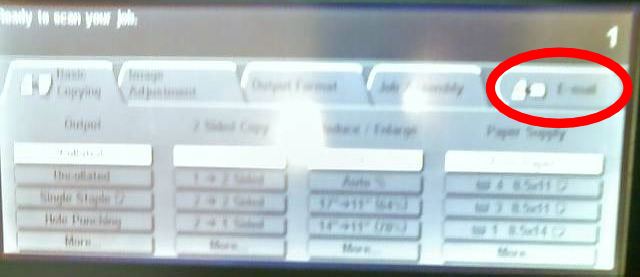
When you select email, it will give you this screen, telling you that you need to login, and offering you this single button with a keyboard icon on it:
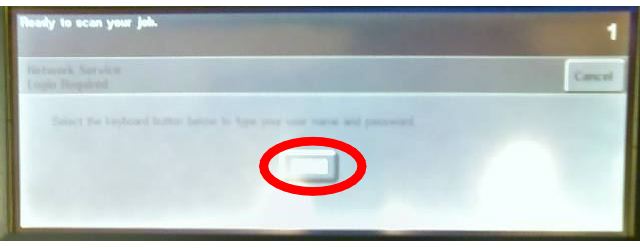
After you press that, you have to enter your username on this screen:
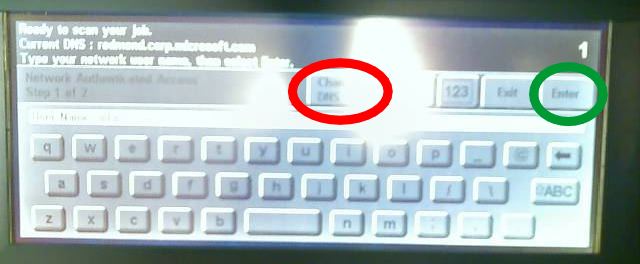
If you are in the default domain shown, then just type in your name (be careful to press right in the middle) and hit Enter (circled in green above); otherwise hit the "Change DNS" button (circled in red above). The DNS screen looks like this:
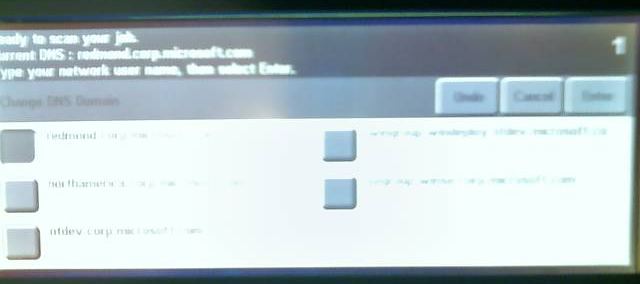
Just pick the one you want and it sends you back to the username screen where you can hit Enter. Then you come to a password screen:
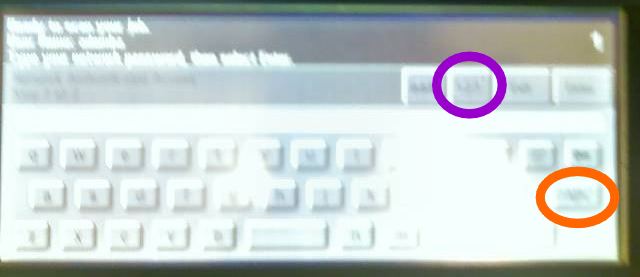
Since we all have strong passwords, you'll need to enter numbers and capital letters; there are buttons to go to a numeric screen (the one in purple, I think, this image is a bit too blurry) and also to caps lock (the one on orange, if memory serves). You then get a quick screen showing the authorization in progress:
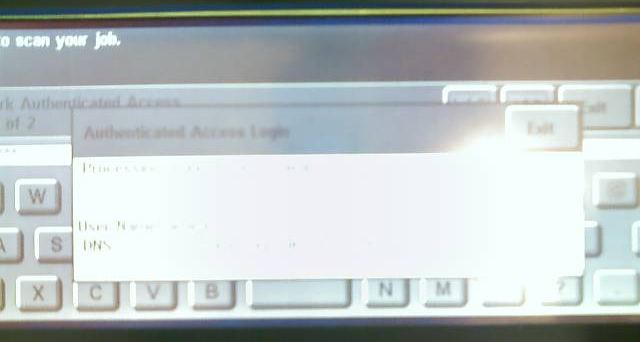
If your fumbly fingers botched the password then you get kicked back to try again; otherwise you come to this screen, where you need to enter the target email address (yours, typically). Press the To: button, circled in red:
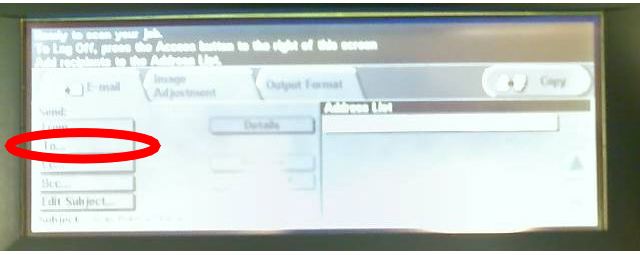
This brings you to an address entry screen, which helpfully has both @ and . buttons, since you need to enter the full address (meaning you include the @microsoft.com part):
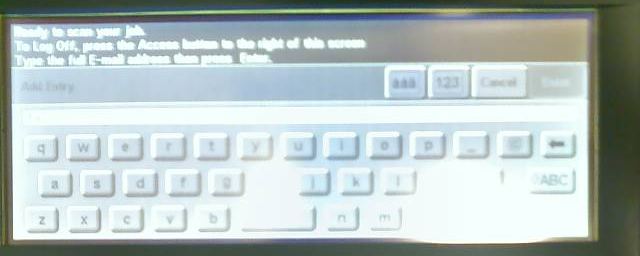
When you've done that, you now come here, with the To: address shown.
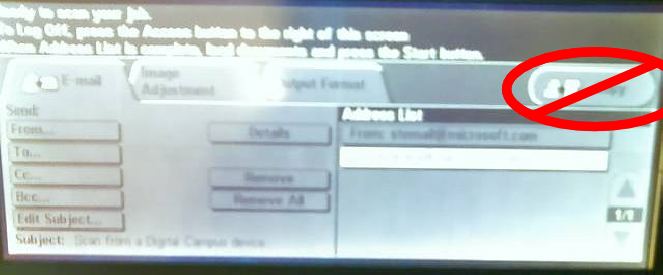
At this point you might be sorely tempted to hit the Copy button (crossed out in red), but don't do that! If you read the fine print, it tells you to hit the Start button. The Start button is actually over on the real button panel, not the touchscreen. It's circled in green:
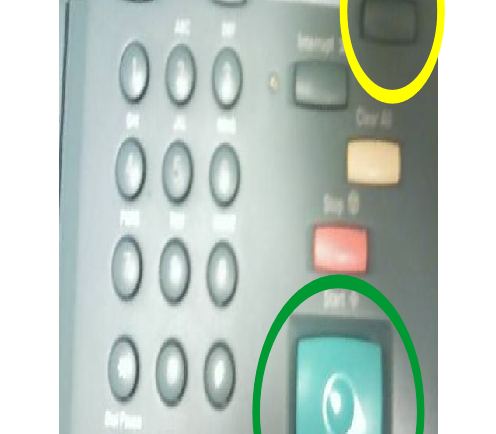
Now it should do the scan and email it. You may be tricked into thinking that nothing is happening, because you don't hear the loud clunking noises you associate with the printer; but actually those come from the paper transport. The scanner is almost silent, so look for the unearthly green glow as it glides over your document. Once the scan is done you need to hit the Access button (also on the real panel, circled in yellow on the photo above), which will then give you a logout confirmation screen:
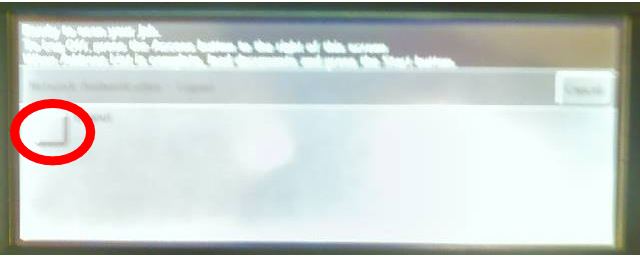
Just select logout, circled in red, and you are a proud member of the "I Scanned It At Microsoft" club.
Posted by AdamBa at 09:47 PM | Comments (5) | TrackBack
August 06, 2006
"The New Yorker" Gets 2006ish
The staid pages of the House of Tilley were recently graced by two articles about the new Web. The July 31 issue had an article on Wikipedia, and the very next week Nicholas Lemann declaimed on "citizen journalism".The Wikipedia article calls it a "lumpy work in progress" where "glaring errors jostle quiet omissions" [dagnabbit, I wish I could write that well. Note to self: use the word "jostle" more]. Still the article winds up being more amused than schocked by Wikipedia. It quotes from detractors, but there's not much of a counter-argument because Jimmy Wales doesn't bother denouncing them, secure in the knowledge that whatever Wikipedia is, it's much more than anyone ever thought it could be.
Writing about proponents of citizen journalism, Lemann comments, "many of the truest believers are very good at making life unpleasant for doubters, through relentless sneering", and follows up with "traditional journalists answering their challenges often sound either clueless or cowed and apologetic". He is careful not to fall into that trap. The result is also a wait-and-see kind of piece. Then again, writing for "The New Yorker" Lemann may also have a snide view of the common hoi polloi journalist, but from the opposite side. He points out parallels with pamphleteering in Britain around the turn of the 18th century (from the book "Representation and Misrepresentation in Later Stuart Britain: Partisanship and Political Culture" by Mark Knights). And he describes reporting as "the tradition by which a member of a distinct occupational category gets to cross the usual bounds of geography and class, to go where important things are happening, to ask powerful people blunt and impertinent questions, and to report back, reliably and in plain language, to a general audience" (this is what I've tried to say elsewhere, if not as nicely, about how there are always going to be a limited number of people who get access to report on specific events that the public is of necessity excluded from).
The existence of both articles shows the trend in the Web. It started out, for lack of anything else (such as home connectivity), as a business-to-business medium (or university-to-university). It then went through the business-to-consumer bubble in 2000. We are now in the consumer-to-consumer phase, although without businesses to jostle against [not bad, but could be better] they really aren't "consumers". Wikipedia and citizen journalism are both about users creating content for other users, the phenomenon that is generating so much excitement and venture capital check-writing today. Whether this is the ultimate direction of the Web, or just another bubble, remains to be seen.
Posted by AdamBa at 05:07 PM | Comments (1) | TrackBack
August 04, 2006
Bruce Payette's PowerShell Book Coming
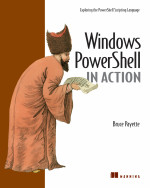 I noticed that Bruce Payette's book on Monad (err, excuse me, I meant PowerShell) is due to come out in November. Bruce is one of the key developers on the Command Line Formerly Known as Monad. He wrote the interpreter and co-designed the language. He's also a resident guru on shells and dynamic languages and all that good stuff. So when he writes about the Shell of Power it is with very deep knowledge both on the details of how it works and the history of why it works that way. I'm looking forward to the book.
I noticed that Bruce Payette's book on Monad (err, excuse me, I meant PowerShell) is due to come out in November. Bruce is one of the key developers on the Command Line Formerly Known as Monad. He wrote the interpreter and co-designed the language. He's also a resident guru on shells and dynamic languages and all that good stuff. So when he writes about the Shell of Power it is with very deep knowledge both on the details of how it works and the history of why it works that way. I'm looking forward to the book.
Posted by AdamBa at 09:54 PM | Comments (0) | TrackBack
August 02, 2006
Travelling Without Baggage
The other day, after rebooting to apply a security patch, my main work machine blue-screened during boot. When I rebooted, the BIOS gave me an ominous message about how the disk was "operating outside of its normal parameters", and it crashed on boot again.So I ordered up a new machine, and tried plugging in the old disk as a secondary drive. With the old disk connected, the new machine also refused to boot; when someone from helpdesk came to look at it, she guessed that Windows was hanging trying to access the disk during startup, and from the pathetic clicking sound the drive was making, it seemed like the disk was seriously broken.
Since this was my main machine and I had been lazy about backing it up (lazy meaning never), basically everything I had done since I came back to Microsoft in 2003 was gone. Now, it's not quite everything: I could still access any code or specs I had done that were checked in to source code control, as well as any documents I had put up on a Sharepoint site, any contributions to a Wiki, any Monad scripts I had blogged here, and email from the middle of March on, which is still stored on my Exchange server. By coincidence mid-March is just after I joined EEG, so basically what I had lost was everything related to working on Monad.
The vast majority of it, of course, was junk. An NT source enlistment, various Monad install directories, accumulated crud I didn't need, documents nobody cared about. There's exactly one document I know I wanted, which was notes I had written up on Scrum: what to do during a planning meeting, what to do during a daily standup, what to do during a retrospective.
But now I have a decision to make. I can send the disk out to a data recovery company that Microsoft contracts with, and it's likely they could get most of the data back. It's actually a two-step process: first they analyze the disk and send you a list of files they could recover, and then if you like what you see you can authorize a greater expenditure of money to actually recover the files.
Right now I'm blissfully unaware of what is on there--it's actually been almost a month since it died and I haven't missed anything. But if I see the list of files, I might feel pangs of loss over certain things. And, it's not clear that I'll be able to justify paying the cost for actual recovery given that most of what is on there is useless. So should I send the disk in for the initial exam?
I'm very tempted to not do it, and remain in my state of happy amnesia. In fact I'm tempted to also throw out all the various printed documents I have left over from my Monad days. While I'm at it, I could junk all the spare keyboards and network cables that I keep around in case I ever need them. And the conference badges and "Monad -- I'm lovin' it" buttons could follow right behind. All I really need to keep are books.
Moving forward, I realize that the way to prevent this from happening again is to not store anything important on my disk. My boss pointed out that my notes on Scrum should have been on our internal Wiki anyway, so others could read it. We have enough other servers to store stuff on, both internal to the team and public within Microsoft, that I shouldn't need to store anything on my disk. It would be awfully freeing to get into this mode, and it would be a good prep for moving to an open workspace where I won't have as much room for physical junk.
But, I'm a bit of a packrat and it's hard to escape the feeling that at least one thing I throw away I'll wind up regretting (I actually had a printout of my Scrum notes, but must have recycled it in a fit of cleansing). So, I have to think about this one.
Posted by AdamBa at 10:45 PM | Comments (6) | TrackBack





